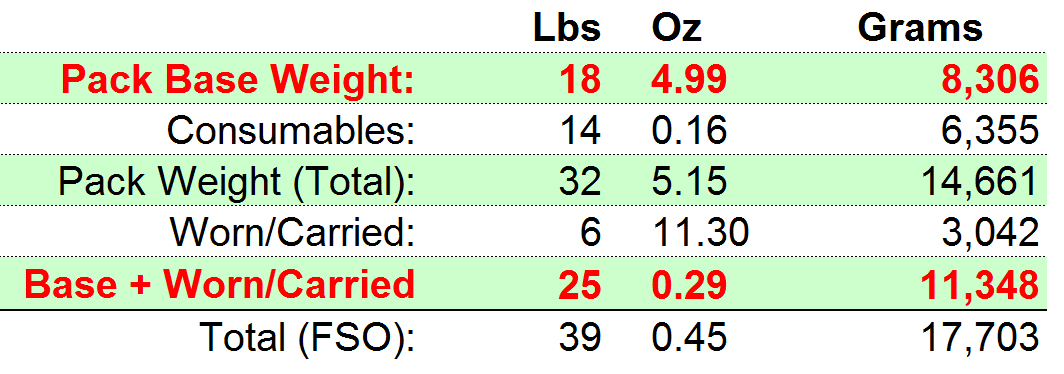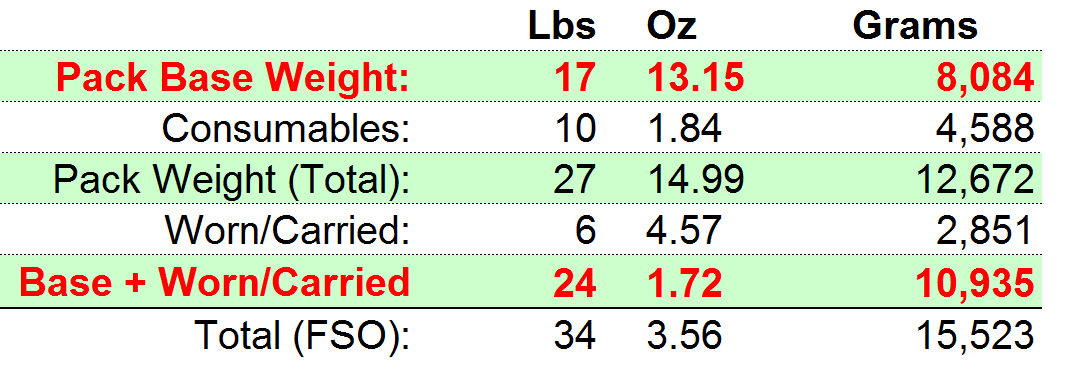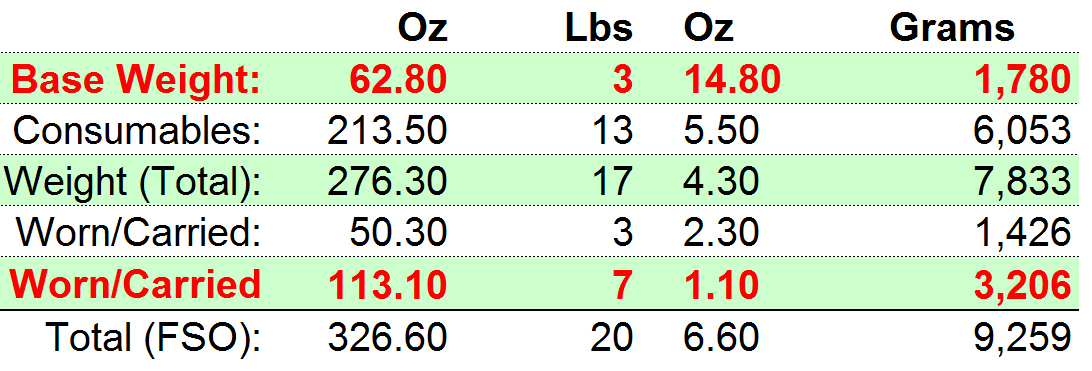EVERYTHING WEIGHS SOMETHING
Until 2008 my method of preparing for backpacking trips was to assemble a checklist, place my gear, water, and fuel into the pack and weigh it. What it weighed, is what it weighed. There was nothing else to do because the gear was what I needed for the specific trip. After playing around with spreadsheets and base weights, I have come back full circle.
My first gear checklist was kept in a notebook. I would enter a description of each piece of gear along with the weight. This allowed me to compare the weight of an item against a new piece I might be interested in purchasing. In the early 80’s I replaced the paper list with a Microsoft spreadsheet program called Multiplan, running on a Commodore 64. That was replaced with an Apple computer running AppleWorks, then Lotus 123 on a PC, and eventually Microsoft Excel. The spreadsheets allowed me to easily compute the total weight of my pack — but the most important use was as a checklist; a list to ensure I didn’t forget anything.
In 2008 I started reading the forums on BackpackingLight.com and found something in common use there: Backpack Base Weight. Base weight is defined as the total weight of the pack excluding all consumables such as food, water, and fuel. The stated purpose of base weight was to allow hikers to compare their gear to other hikers, with the theory that the base weight works for short or long trips; the only variable being the amount of food and fuel needed for trips of different length of days on the trail.
I then noticed that many folks were classifying these base weights, and even defining themselves based on their own backpack base weight. Hikers became lightweight hikers, ultralight hikers, super ultralight hikers, and even extreme ultralight hikers. One amusing thing I saw were a lot of gear lists with a bunch of stuff carried in pockets, which got the base weight below some arbitrary weight since anything in pants or shirt pockets is not included in the backpack base weight. There is no “official” classification of base weights and every hiker who subscribes to a classification system probably has their own definition. Below are some I have seen and they seemed to be popular among many hikers. Other hikers have different definitions.
- Light = under 20 lbs
- Ultralight = under 10 lbs
- Super Ultralight = under 5 lbs
- Extreme Ultralight = under 2.5 lbs, or a total weight of everything worn or carried under 5 lbs (consumables excluded)
If you are a backpacker you may not agree with these classifications or better yet, like me, you may have finally come to the conclusion that the base weight idea is silly.
TALKING ABOUT WEIGHT
Most backpackers are concerned about weight. Fact is, you have to carry gear, and the heavier it is the more work it becomes. In my opinion, the smart backpacker always scrutinizes his or her gear and pares it down whenever possible.
But at the end of the day, it doesn’t matter what your base weight is; what matters is how much the entire pack weighs. For most of us, especially on longer trips, food and water and fuel are our heaviest items.
So how does one go about reducing back weight? Normally reducing consumables isn’t smart unless the hiker is carrying much more than will be consumed during the trip. Typically the four heaviest items are:
- Sleeping bag or quilt
- Sleeping pad
- Shelter
- The backpack itself
REDUCING WEIGHT
Always keep in mind that staying warm, dry, and safe are the primary considerations. Don’t get rid of anything that may jeopardize your well-being; but at the same time don’t take a lot of things “just in case.” Analyze the first three items above and replace with them with lighter versions if you can. Often lighter versions are expensive and may not fit into your budget. Also lightweight gear may not be as robust as your current gear, and requires additional skill to use.
Often the backpack is a hiker’s heaviest item, and many rush out and replace a 7 pound backpack with minimal backpack, which cannot support all the remaining gear comfortably. Good quality backpacks usually have sophisticated suspensions and hip belts that make carrying your gear much more comfortable than something extremely light. A quality pack doesn’t have to weigh 7 pounds.
However, keep in mind that the backpack is the foundation of the house on your back, and it is the one piece of gear you use the most since you are hiking with it every day you are on the trail. Let me give an example.
On many trips my base weight is around 5 lbs (or even less) and my pack is a zPacks Zero, which weighs less than four ounces. But it does not have a frame or a hip belt that can transfer the load to my hips, which is the best place to carry weight. So the entire pack weight is carried by my shoulders, the straps being the only thing that supports the weight. This isn’t a problem with 5 pounds or 10 pounds. But much more weight than that, the pack becomes uncomfortable. Now if I add 5 days of food (1.5 lbs per day) and a gallon of water for desert hiking to a 5 lb base weight, the total pack weight is now around 21 pounds – very uncomfortable for me. Of course each day I lose 1.5 pounds of food as I eat it, but each day I may need to refill all my water bottles. I am not going to carry 20+ pounds with such a light pack.
Let’s take the same scenario and exchange the Zero with my McHale Bump backpack, which weighs almost 3 pounds with most of the options. Now my total pack weight would be 24 pounds, with a sophisticated suspension that transfers the entire weight of the pack to my hips, and the shoulder straps are only used to keep the pack balanced and close to my back. I am much happier, comfortable, and can hiker longer and faster with this heavier set-up. Is there a downside? Yes, my base weight is not longer SUL, but in the middle of the UL category at 8 pounds, and I no longer have bragging rights of being a super ultralight backpacker. But how in the expanse of the universe does SUL versus UL matter? Or in layman’s terms… who gives a rat’s ass?
After dialing in your pack, shelter, and sleep system, ask yourself, “Do I need a 1 pound Rambo knife, when a small pocket knife or razor blade will suffice? Do I need a huge first aid kit with items I have never used, or I am not medically qualified to use?”
I think you get the idea.
OTHER STRATEGIES
Eliminate duplicate items
Do you really need a map, compass and a GPS unit? Learn to be expert with map and compass, and leave the GPS at home. Do you need two sets of clothes?
Single items of gear for multiple uses
Do you really need a pillow? Use your down jacket, or put your shoes or water bottles in a stuff sack. If you carry trekking poles, they can double as shelter poles with some kinds of tents or tarps. The list goes on and on with a little imagination.
“TRADITIONAL” BACKPACKERS
Decades ago my base weight was usually less than 20 lbs — which (surprise, surprise) meets that magical “lightweight” category. And my total pack weight with consumables was rarely more than 35 lbs… this is contrary to the perception that years ago backpackers carried 60+ pound packs! Seems today many backpackers think that lightweight backpacking techniques were invented by Ray Jardine in 1992 when he published The Pacific Crest Trail Hikers Handbook, and further refined by a slew of so called experts. Heck, its only walking and nothing more.
Last year and this year I took trips taking the same gear I used for nearly 40 years starting in 1971 and the base weight was less than 20 lbs, which today is magically considered “lightweight.” You can read about one trip here that included the gear below.
and a similar trip and gear list here.
OTHER THOUGHTS
Lately I have stopped publishing my gear lists as part of my trip reports. Unless my son Joe would find them interesting they really don’t add anything to a trip. My gear is chosen to meet a specific trip given the terrain, location, season of the year, etc. Some trips the base weight is less than 5 lbs other times almost 20. It really doesn’t matter. What matters to me is getting out as often as possible and enjoying myself. The title of this website includes “ultralight backpacking adventures” but I didn’t intend it to be a classification of pack weight – more of a mindset, as in ultralight aircraft where pilots don’t have classifications of weights.
Last year in The Death of Ultralight Backpacking, I wrote
For me ultralight is a mindset. The ultralight backpacker relies on experience, skill, and knowledge. His gear is pared down to eliminate all unnecessary items, and each piece of gear is carefully selected based on the requirements, expected conditions of the trip and the hiker’s skill. Weight is a prime consideration, based on what the gear needs to do.
I still stand by those words. And what am I? I am just a backpacker.
SAMPLE TRIPS
Below are some sample weights with links to the trips I used them. I thought about this quite a bit and something told me not to include them, as it sort of goes against what I have written so far. But in the end, it doesn’t matter. Each of these trips were special and I thoroughly enjoyed myself. I could have changed the gear for each trip to meet some arbitrary weight, but that wasn’t the point. The point was the journey, not the gear. Gear is always secondary.
Extreme (XUL)
This was an experiment to see if I could assemble a kit that would weigh under 5 lbs From the Skin Out (FSO), excluding consumables (food, water and fuel). There is no “accepted” definition of XUL. Some people try to do sub 5lb FSO and others a pack base weight under 2.5 lbs.
I wanted the kit to be able to handle night time temperatures around 32 F, and handle cold rain. It had to be able to handle multiple days of hiking, with at least a distance of 50 miles. The only thing on this list I would not normally use or even bring on a backpacking trip is a smart phone. Since my iPhone is lighter than my camera and could theoretically replace a watch, compass and map, I took it on the trip. The problem with a phone is battery life, and an iPhone does not have replaceable batteries. Also the area I hiked is familiar to me, so a compass or map was not critical, although I did consult the map for some canyons I had never hiked in before.
It was a fun trip and I pushed the limits. To be honest it wasn’t very difficult and an air mattress would have made the trip much more enjoyable.
Super Ultralight (SUL)
Many of my 3 season weekend and many longer trips are with a SUL gear list. This is defined as a pack weight under 5lbs, and does not include consumables. Most of my trips are in desert climates where water is scarce and a SUL kit means I need to carry a total pack weight of 15-17 lbs, including food and water. To get under 5lbs, one needs to carry a frameless pack, and I find anything over 10 or 12 lbs to be uncomfortable as I get older.
Also as I get older, I am finding I sleep much better with an air mattress than a foam pad, and nowadays find that my base weights are creeping over 5lbs into the “Ultra-light” category. The attached SUL gear list is pretty much what I have been using for the past several years. A typical trip can be found here.
Ultralight (UL)
More and more my trips have a base weight approaching 10 pounds. Click here for and example of this kind of trip.
FINAL THOUGHTS
Get out and hike as much as you can if you love backpacking. Be smart about minimizing weight, but don’t get trapped into trying to reach an arbitrary weight threshold. And never, ever try to define yourself as a XXXXX Backpacker. We are all backpackers and that is the only important thing!




